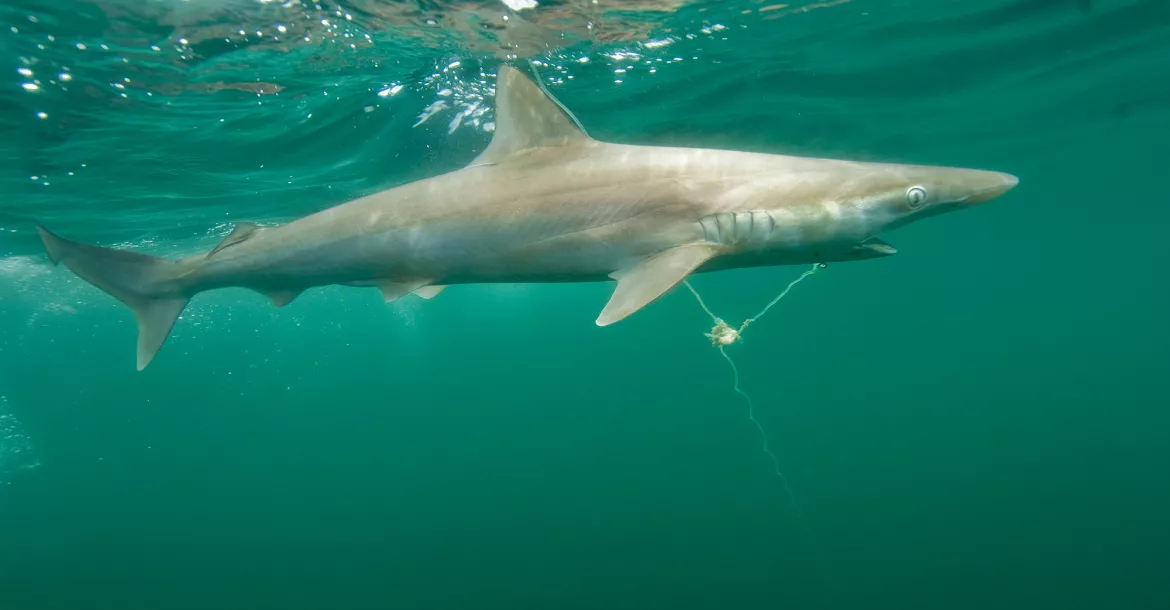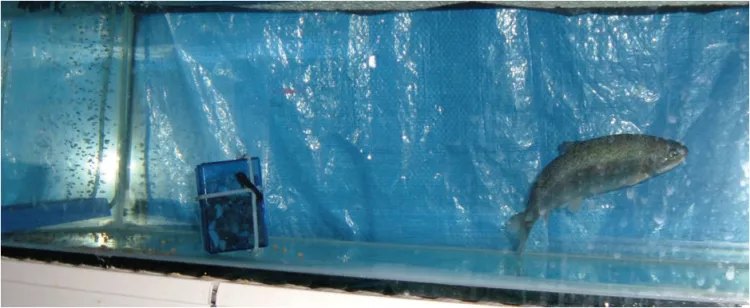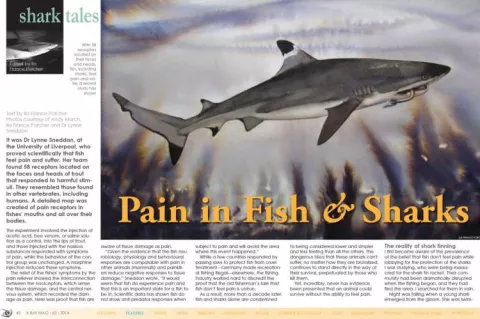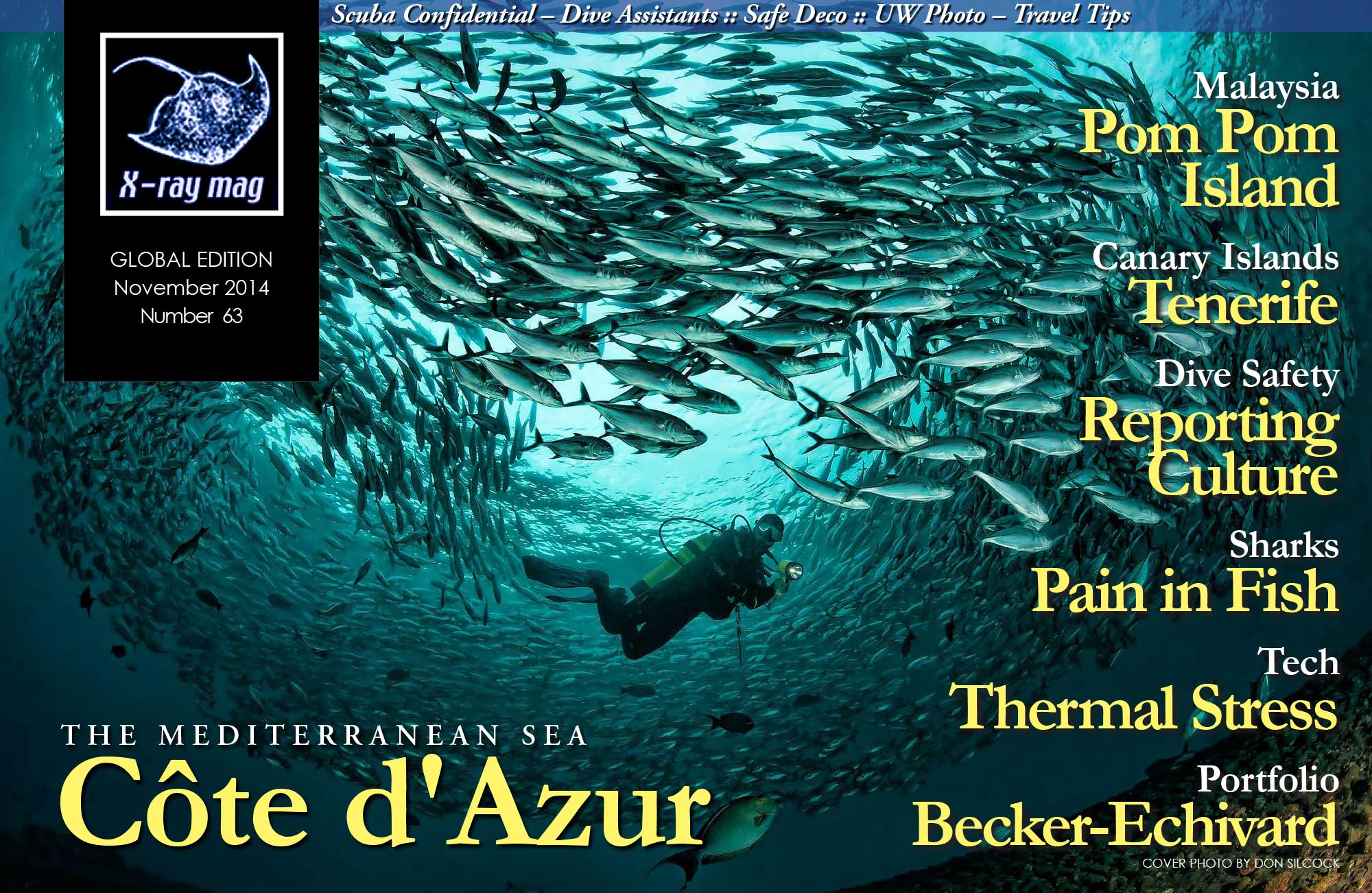It was Dr Lynne Sneddon, at the University of Liverpool, who proved scientifically that fish feel pain and suffer. Her team found 58 receptors located on the faces and heads of trout that responded to harmful stimuli. They resembled those found in other vertebrates, including humans. A detailed map was created of pain receptors in fishes' mouths and all over their bodies.
The experiment involved the injection of acetic acid, bee venom, or saline solution as a control, into the lips of trout, and those injected with the noxious substances responded with symptoms of pain, while the behaviour of the control group was unchanged. A morphine injection reduced these symptoms.
Contributed by
Factfile
Ila France Porcher, author of The Shark Sessions, is an ethologist who focused on the study of reef sharks after she moved to Tahiti in 1995.
Her observations, which are the first of their kind, have yielded valuable details about their lives, including their reproductive cycle, social biology, population structure, daily behaviour patterns, roaming tendencies and cognitive abilities.
Her next book, On the Ethology of Reef Sharks, will soon be released.
The relief of the fishes' symptoms by the pain reliever showed the interconnection between the nociceptors, which sense the tissue damage, and the central nervous system, which recorded the damage as pain. Here was proof that fish are aware of tissue damage as pain.
“Given the evidence that the fish neurobiology, physiology and behavioural responses are comparable with pain in other animals (mammals) and painkillers reduce negative responses to tissue damage,” Sneddon wrote, “it would seem that fish do experience pain and that this is an important state for a fish to be in. Scientific data has shown fish do not show anti-predator responses when subject to pain and will avoid the area where this event happened.”
While a few countries responded by passing laws to protect fish from cruel treatment—Germany made recreational fishing illegal—elsewhere, the fishing industry worked hard to discredit the proof that the old fisherman’s tale that fish don’t feel pain is untrue.
As a result, more than a decade later, fish and sharks alone are condemned to being considered lower and simpler and less feeling than all the others. The dangerous idea that these animals can't suffer, no matter how they are brutalized, continues to stand directly in the way of their survival, perpetuated by those who kill them.
Yet, incredibly, never has evidence been presented that an animal could survive without the ability to feel pain.
The reality of shark finning
I first became aware of the prevalence of the belief that fish don't feel pain while lobbying for the protection of the sharks I was studying, who were being massacred for the shark fin racket. Their community had been dramatically disrupted when the fishing began, and they had fled the area. I searched for them in vain. Night was falling when a young shark emerged from the gloom. She was swimming with a lethargy I had seen only in dying sharks—a large hook was embedded through the angle of her mouth, with a long tear beside it. She circled once, in slow motion and glided listlessly away, became a shadow, a movement in the coral, and vanished.
She was only the first. A nightmare began in which I alternated between searching for the sharks I knew, and beseeching people to write to the government to ask that they be protected. The graceful adolescent shark eventually lost the hook, but her jaw had been damaged and she could no longer close her mouth. She lost weight over the following weeks, and within two months, she died. I wondered sadly if people who fished for fun would still do so, if they could see the unimaginable suffering that they caused.
Fishermen's arguments
But while I protested over the Internet that shark finning had hurled the sharks into a black hole of suffering, and that all sharks, all over the world, were in danger of being sucked into it, fishermen wrote to dismiss my concerns, and assure me that fish don't feel pain.
With the response of the community of sharks that were being massacred fresh in my mind, I couldn't believe what I was reading. I replied that the sharks who had escaped, as well as female sharks with extensive mating wounds, showed similar signs of pain and suffering as the mammals and birds I treated for painful injuries, as a wildlife rehabilitator. They were less alert, less responsive, and swam unusually slowly.
Pain is a warning sensation that is important for survival, and only a small percentage of fish who come into the world actually make it to adulthood—any weakness dooms them. An inability to feel pain would result in inappropriate behaviour, and the fish would go straight into evolution's garbage can.
If they did not feel pain, that should be supported by observable behaviour, yet fish and sharks are shy and cautious. When you see a shark slam the side of her body against a sand bank to dislodge her remora, the question just pops out of a slot: If she couldn't feel pain, would she be so irritated by the soft touch of a remora?
Fishermen argued that they had seen sharks continuing to function in spite of terrible wounds. But this is common—even injured humans will continue to fight for their lives as long as they can when in mortal danger. The effect has an obvious benefit for survival. Others argued that fish could not feel pain because sometimes a fish will bite a baited hook a second time, after being unhooked and thrown back into the sea. But, while it may be obvious to the fisherman what he is doing, how could it be obvious to the fish?
These men assumed that the fish understood much more than it possibly could about its situation. It could have no basis among its experiences for understanding the fisherman's practice of deception. It can see no dangerous predator underwater, so how could it imagine that above the surface a man is waiting, hoping to trick and kill it? Even a human walking by the sea, would never suspect that there was a creature waiting for him beneath the surface, with a plan to trap and kill him.
A fish that had already bitten a bit of food with a hook in it, has no reason to assume that the next piece of food it finds will also hide a hook. It was daunting, how many people were proud of their efforts to outwit fish. They didn't see any irony or contradiction in their claims that fish were too simple minded to feel pain, when they were so very proud that they were intelligent enough to outwit them.
A fisheries article
Further investigations revealed that in 2002, fisherman James D. Rose had published an article in a fisheries journal, asserting that fish cannot feel pain. He alleged that though they may seem to feel pain when hooked and yanked out of the water, they lack the brains to be aware of it. Fish lack the neocortex, the folded, outer layer of the brain that is so highly developed in humans, so cannot feel pain, he claimed.
According to him, the neocortex is the seat of all higher mental functions, so the required neurological machinery to feel pain is missing in fish, and indeed, is present only in humans and apes. But he did not give a reason to claim that awareness of pain depends on the neocortex, and he had done no study to back up this idea.
In focusing on a comparison of the human brain with the fish brain alone, and omitting mention of the evolution of the vertebrate brain, Rose's article seemed biased and anthropocentric. From fish to man, the brain has the same structures, arranged in the same way. The only exception is the neocortex, which developed in mammals. Neurological studies have shown that the newly evolved neocortex of mammals took over certain higher functions which were already present in fish, amphibians, reptiles, and birds.
A study of the differences between vertebrates as they grow increasingly complex reveals the thread of evolutionary continuity, and shows that no new ability or organ can suddenly appear in an animal without that feature having evolved in its ancestors. The implication is that the sensation of pain evolved along with all the other sensory systems.
Fish have elaborate forebrains, and expansion of the forebrain has occurred many times in different species—the degree of development has been correlated with cognitive abilities. Fish continue to develop neurons throughout their lives, and do so at a faster rate when confronted with a stimulating environment, indicating a link between experience and neural development.
It is well established that birds feel pain, and have advanced cognitive abilities. Some species have better long term memories than humans, and others far exceed us in visual recognition. Yet their little pea-brains lack a neocortex.
Tests with birds have shown that higher mental capabilities can be found in a brain that is wired differently than ours. Dolphins, too, show high cognitive capabilities, yet their brains have a different form than primate brains, though both are mammals. There are people in which the expanded neocortex failed to develop, but who have normal psychology and IQs. So even in humans, it seems that the neocortex is not necessary for consciousness.
Other researchers found that the interconnections within the core of the brain was the essential neurological basis of conscious awareness, and concluded that the neural system involved in the sensation of pain, likely evolved as an “interactive dynamic system” with the cognitive processes, in the evolving central nervous system. These findings and others suggested that it is the way the various regions of the brain are integrated, and the continuous interplay of neural messaging within it, that generates consciousness.
Donald R. Griffin, the pioneer of cognitive ethology, theorized that the expanded human brain was more likely to have permitted the complex subconscious mind, and that consciousness had developed with the centralization of the nervous system, which was favoured by evolution due to its survival value.
Cognition in Fish
Cognition, or the ability to think, seemed to be a relevant aspect in the establishment of whether fish could feel pain. In the same year as Rose's article was published, Redouan Bshary, Wolfgang Wickler and Hans Fricke published a review of the findings of the cognitive capabilities of fish entitled Fish cognition: A primate's eye view.
The review covered a surprising range of evidence of fish cognition, and concluded that the main cognitive difference between primates and fish was the ability to imitate. From nest building, to complex social behaviour, the abilities of fish were impressive, suggesting that they could not possibly be as simple minded as Rose had claimed.
Like sharks, fish have been shown to possess traits that distinguish one individual from another. They exhibit clear preferences, use tools, can learn complex tasks, and have long term memory, showing that they have the ability to make decisions and to remember negative events.
Rose ascribed only Pavlovian learning to fish, but in reviewing the relationship between learning in fish, memories, and conscious cognition, those who were actually doing research on the subject concluded that some fish behaviour is better explained within a theoretical framework that includes primary consciousness. A state of basic consciousness is now thought to be present in animals whose nervous systems have evolved sufficient complexity, and it is believed that cognitive studies may be used to assess consciousness and sentience.
Yet, all of this easily available evidence that contradicted Rose's conclusions was omitted in his article. He seemed to rely on the beliefs of fishermen, that the fish brain was so simple that it was well understood.
But no brain is simple, as anyone who has observed the activities of a spider will appreciate.
Veterinarians speak out
With their training in healing, and experience with distressed animals, I felt that veterinarians were in a better position than fishermen to judge whether or not an animal was in pain, and queried those who advised me on my rehab cases.
An avian specialist in Australia, Dr Pat Macwhirter, wrote that she had assisted in surgery on a fish when a fish vet had come to work at her bird hospital, and that the fish had been more sensitive than a bird to electro-surgery. As a result of its high sensitivity to pain, the anaesthesia had been deepened. There was no doubt, she told me, that the fish had been in pain.
Another bird specialist, Dr Ross Perry, also in Australia, wrote me the following story:
“I have befriended a wild eastern blue groper, Achoerodus viridis, that has a passion for sea urchins, the big ones with long sharp dark purplish red spines. She is very selective in how she approaches the sea urchin before striking it repeatedly to crack it open and suck out the contents.
Groper have big fleshy lips and tiny teeth. She prefers me to uncover the underside of the urchin and to hold as many spines back out of the way as practical before striking. Even so a large spine broke off in her lip that fortunately left enough sticking out for me to cuddle her on her return so I could grasp the spine with finger and thumb and pull it out. This has transformed my thinking about fish as sentient beings.”
Indeed, how could spines have evolved as protection for sea urchins, if fish did not feel pain? The ocean is full of creatures that depend on stingers or spines for protection, and the fish that eat them, such as gropers and triggerfish in the case of sea urchins, show complicated cognitive behaviour in their efforts to do so while avoiding the spines.
The best way to relieve pain in fish during surgery has been meticulously researched, and pain relief is systematically used by veterinarians who perform surgery on fish. For them, the pain system in fish is virtually the same as in birds and mammals. Given that they are conscious, and may suffer on an emotional level, fish welfare emerges as an important issue.
Findings on pain in fish
Since animals cannot tell us how they feel, scientists have searched indirectly for evidence about their subjective experiences, in the studies of neuroanatomy, neurophysiology, and in their behaviour. They have developed strict criteria, all of which need to be met, before one can conclude that an animal can feel pain.
First, there must be nociceptors, sensory neurons which respond to tissue damage by sending nerve signals to the spinal cord and brain. There must be neural pathways from the nociceptors to higher brain regions, and the signal from the nociceptor must be processed in the higher brain, not in the reflex centres in the hind brain or spinal cord.
There must be opioid receptors within the nervous system, and opioid substances produced internally. Pain killing drugs should relieve the symptoms of pain that the animal displays, and it should be able to learn to avoid a painful stimulus.This should be so important to the animal, that it avoids the threat of pain right away. The painful event should strongly interfere with normal behaviour; this should not be an instantaneous withdrawal response, but long term distress.
Fish conform to all of these criteria. Their nociceptors are nearly identical to those found in mammals and humans. These are connected to the brain through neurons. There are also connections between the different structures of the brain, including those which are considered crucial to the experience of pain, and the whole brain of the fish is active during painful events.
As well as neural activity, certain genes that are crucial to the experience of pain in humans are also found in fish, and they are active throughout the fish’s brain during painful events.
This activity of the brain at the molecular, as well as the physiological level, indicates that these are not reflex reactions, as Rose claims. If they were, such activity would not be seen in the higher brain.
Fish have displayed a variety of adverse changes in their behaviour after the infliction of pain. An extreme increase in their ventilation (respiratory) rate, may be followed by rubbing the damaged parts on the substrate, rocking on their pectoral fins, trying to stay upright, and no longer feeding.
These, and other symptoms of distress, are relieved by the administration of morphine, which completes the circle, identifying pain as the cause of the change in behaviour. Like other animals tested, fish have been shown to self-administer painkillers if they can, even if that means going into a location that they do not like, to bathe in water that medicates them.
This is another clue that the fish was suffering, and found relief in the undesirable location.
Fish swiftly learn to avoid painful events, which researchers think indicates that they are conscious—they experience the pain so severely that they are strongly motivated to avoid feeling it again, even after just one exposure.
Though humans can over-ride pain at times in certain heightened mental states, and particularly when they are in danger, it seems that fish cannot do so. Studies have shown that after being hurt, fish become far less alert to danger, as if their pain is too overwhelming for them to ignore it, even to escape a predator. It is thought that due to their simpler neural design and mental states, they lack the ability to think about their pain, and put it in perspective as humans can. Pain for them seems always to be an intense experience, which suggests that they may actually feel pain more intensely than humans!
When researcher Rebecca Dunlop discovered that fish learn to avoid painful experiences, she wrote, “Pain avoidance in fish doesn't seem to be a reflex response, but rather one that is learned, remembered and is changed according to different circumstances. Therefore, if fish can perceive pain, then angling [fishing] cannot continue to be considered a non-cruel sport.”
Research has been done to find ways to minimize the pain fish suffer during fishing. The physiological state resulting from being hooked and reeled in, and the types of damage caused by being fished and handled by fishermen, have been closely studied. As a result, guidelines have been developed for fishermen to follow to minimize the suffering of the fish they catch.
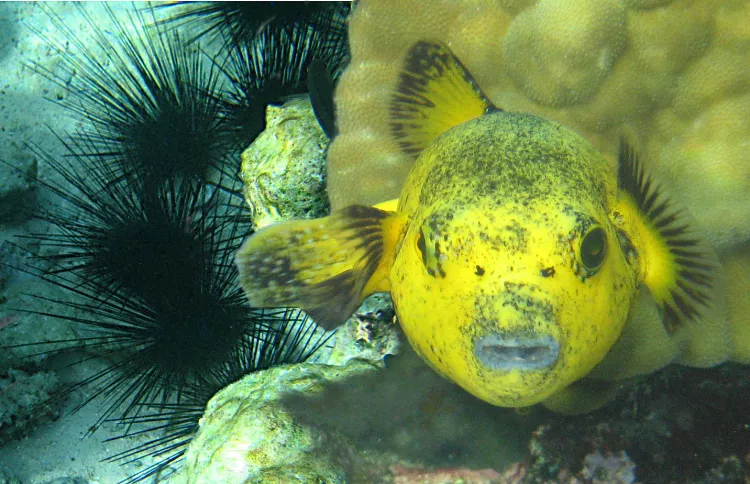
The length of time the fish is kept out of the water is of vital importance, along with the damage caused by the hook. Nets, especially knotted ones, cause abrasions; this can be avoided by using a soft net. The roughness with which the fish is handled, and the use of “stringers,” which are especially harmful, are also crucial to the degree of suffering, and the threat to the animal’s survival.
Pain avoidance in fish doesn't seem to be a reflex response, but rather one that is learned, remembered and is changed according to different circumstances. Therefore, if fish can perceive pain, then angling [fishing] cannot continue to be considered a non-cruel sport.”
But these developments failed to become common knowledge, and in 2012, Rose published yet another paper that declared that fish could not feel pain, in an argument that again condensed to the idea that fish pain was not human pain, so could be ignored. He misrepresented Dr Sneddon's findings, so she wrote a rebuttal to the journal, but it was not published. Rose is a member of recreational fishing groups in the United States, which suggested that his review was written for political reasons.
Fish and humans share approximately 50 percent of our genes, and the lionfish shares about 80 percent. They and puffer fish are considered by researchers to be so similar to humans genetically that they are being used as model organisms for some research.
The idea that there is a huge gulf between humans and animals is a religious one, which initially gained stature scientifically through the work of René Descartes back in the 17th century. Its use to justify inflicting pain and suffering on other life forms, particularly for pleasure, should be fought wherever it rears its ugly head, in the interests of continuing to establish a moral society.
Shark fishing as fun
Just to put this political affair in perspective, according to the NOAA, the fishing industry generated one $199 billion dollars in sales in the United States in 2011. And it is in the United States, home of Shark Week, that monster tournaments became popular after the movie Jaws, and fighting sharks for fun and excitement became popular. Though the wholesale slaughter is giving way to catch and release, the question of whether such a practice can be morally justified must be asked.
One of the most famous American shark fishing captains, Frank Mundus, has been quoted in the book, In the Slick of the Cricket, as saying :
“Feeling good about tagging and releasing sharks was folly. The cheaper hooks bought by the weekend warriors were more often than not swallowed by the sharks which then fought their final battle gut-hooked. After being released, most sank to the bottom, dead. Maybe two out of 12 are hooked in the mouth. Add it up along the coast.”

Sharks are not trout. They are large animals who have to swim forward continuously to keep oxygen flowing over their gills, and their horizontal undulation is like a heart beat—they can’t stop, no matter how much pain they may feel as they are inexorably pulled by the big hook in their guts or faces to the surface, no matter how powerfully they try to escape. Given that fish suffer as other animals, there is no doubt that the suffering of sharks at the hands of “sports” fishermen is extreme.
Though they are thought of as being tough, sharks evolved with their weight supported at all times by the water in which they live, and lack a bony skeleton, so they are more fragile than they appear. As any wildlife rehabilitator learns, serious injuries to wild animals are usually fatal without the benefit of treatment and supportive care.
Recreational fishing is a blood sport that has not received the cultural bias against it that hunting has, and fish have not been protected from needless suffering by law as reptiles, birds and mammals have. While deliberate cruelty to other animals is prosecuted, the motives of people who think that it's “exciting and fun” to brutalize a shark, are not questioned.
The view underwater
When the massacre of the sharks I was studying began, the entire community of sharks fled, and it never reformed as it had been. Those who had escaped appeared swimming unsteadily, and more weakly than sharks I had seen close to death from illnesses. They displayed the same symptoms of pain shown by the birds, reptiles and mammals I was familiar with as a wildlife rehabilitator. They were less alert, less responsive, and they swam slowly, erratically, sometimes looking off-balance. The recovery of their normal swimming pattern when they lived, took up to two weeks.
Large hooks remained twisted into their mouths and often into the jaw itself, where they interfered with the sharks’ ability to eat. Some lost weight and died in the next months. The hooks took weeks, and in some cases months, to rust out. The fishing line they trailed became covered with algae to a thickness of several centimetres. Some continually jerked their heads away from the drag as if the heavy weight pulling on the hook was a steady source of discomfort. Juveniles appeared exhausted by it and disappeared before losing the hooks.
The answer to my question, “Would fishermen still kill sharks for fun, if they could see the unimaginable suffering that they caused?” was clear to see. They would, and they do.
There appears to be a mindless acceptance of a tradition resulting from a discovery in the Stone Age, and, incredibly, still bragged about in the computer age. Fishermen have managed to take and keep control of the way fish and sharks are thought about and treated, and their communal agreement that these intelligent and sensitive animals deserve no better treatment than logs, continues to dominate. ■

